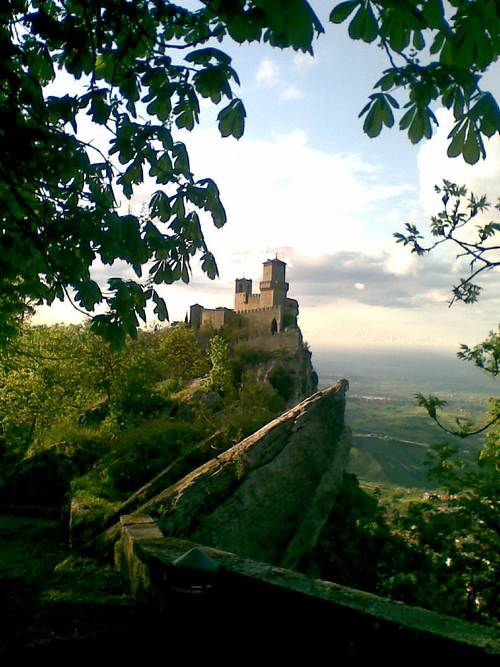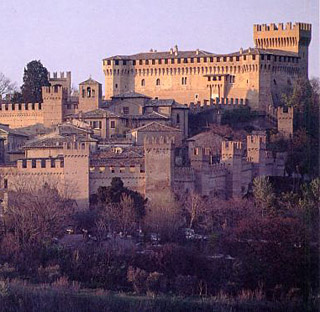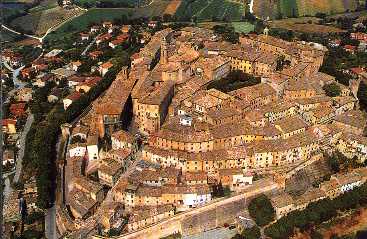DISCOVER HISTORICAL ROMAGNA
Not Only Sea
Our itineraries principally wind along the Conca, Foglia and Marecchia river valleys. These territories are included in the historical (not administrative!) region called “Romagna Storica”, whose borders join Montefeltro and Marche.
Ideal for biking: you can ride from the first hills just in front of the sea until the Appennino mountains of Romagna, Marche and Tuscany.Even if you prefer mountain-bikes, you will find several minor country roads and pathways which no longer carry local traffic, but used to connect the various villages.
You can enjoy the beach (Cattolica, Gabicce, Riccione) or the wonderful natural park of Mount St. Bartolo, visiting its marvellous bays, like Fiorenzuola.
During rest days (or for non cycling friends) you can spend your time discovering the fascinating artistic towns of our territory or following the “Strada dei vini e dei sapori” (wines and tastes route), the famous route where vineyards, handcrafted products, olive pressing etc can be found.


SEA AND HILLS
What To See
RIMINI: Augustus’ marble arch, Tiberius’ bridge, surgeon’s ancient Rome domus (I cent. b.C.), Malatesta Temple (XV cent), Sismondo castle (cent. XV)
CESENA: Malatesta library (cent. XV)
FAENZA: Milzetti palace (cent. XVIII-XIX)
PESARO: villa imperiale (sec. XVI)
URBINO: duke palace (cent. XV)
RAVENNA: Byzantine mosaics (cent. IV-VI)
FANO:Augustus’ arch (cent. I a.C.), Malatesta castle (cent. XIV-XV), monumental Malatesta sepulchres
MALATESTA FORTRESSES: Santarcangelo, Verucchio, Montebello, Torriana, Pennabilli, Saludecio, Mondaino, Montegridolfo, Montefiore Gradara-Fiorenzuola di Focara-Castel di mezzo
MARCHE VILLAGES:Val Foglia, Val Metauro, Valle dell’Esino
ART TOWNS
– Rimini
– Urbino
– Pesaro
– Cesena
– Ravenna
– Fano
NATURAL PARKS AND TREKKING
– St Bartolo mount natural park
– Sasso Simone e Simoncello natural park
– Onferno Caves
– Frasassi Caves




















SOME ITINERARIES
Art Towns, Sea e Castles
Art Towns
Rimini
Not just beach and sun! Rimini is a nice historical and art town, with its amazing ancient Roman (Augustus arch, Tiberius’ bridge, surgeon’s domus), medieval (Giotto’s crucifix and XIV century Giotto’s school of frescos in Rimini, in St Agostinus’ church) and renaissance masterpieces (Malatesta temple by Leon Battista Alberti; Piero della Francesca’s famous fresco, Agostino di duccio’s stuccos and decorations and Sismondo castle).
The little ‘town museum’ is very interesting. It preserves local mosaic carpets and an important paintings collection, mostly XVI century: Cagnacci, Guido Reni, Centino…
Urbino
An ideal town, heart of Italian Renaissance, capital of Montefeltro. Don’t miss the palace of dukes, built as a town by Federico da Montefeltro and Luciano Laurana architect, Leon Battista Alberto consultant and Francesco di Giorgio Martini last (but not the least)constructor.
Amazing the round towers (façade to Rome; you can see it from Piazzale Mercatale), the little studio with wooden trompe-l’oeil inlaid panels, and XV century private bathroom, toilet and thermal baths (the first private bath in Italy and Europe since Roman period!).
You can visit the National paintings gallery hosted in the palace (Raphael, Piero della Francesca, Titian…)
Pesaro
Villa Imperiale, setted on the panoramic road through the St Bartolus’ mount natural park (from Pesaro to Gabicce) is one of the most important Renaissance country house (as important as Palazzo Te in Mantova and Villa Madama in Rome).
It has been built at the beginning of XV century by Francesco Maria I della Rovere and his wife Leonora Gonzaga, on a previous little malatesta fortress. It shows to the visitors wonderful wall decorations and frescos by Dosso Dossi and Raffaellino del Colle (Raphael’s pupil), but the most amazing section is not the building itself, but the extraordinary gardens: secret gardens, roof gardens…
Pesaro also offers to the tourists an interesting historical and archaeological heritage: the Romanesque cathedral with mosaic carpets (V-XII centuries), the XVI century Palace of the dukes and the castle (Rocca Costanza) by Luciano Laurana.
Gioacchino Rossini, the famous musician, was born here in Pesaro. Every year the town commemorates the figure with the international Rossini Opera festival in the neoclassical (early XIX cent.) town theatre.
Cesena
The town was ruled during XV century by Novello Malatesta, Sigismondo’s brother. The 2 brothers were very different: Sigismondo was a warrior, Novello was a culture-man. He established the public malatesta library. This is the only library numbered in the UNESCO heritages of humanity. The visitor can, still now, see the Renaissance library, because the desks are still those desks, and each ancient illuminated hand-written book is exactly setted in the original position. Every scholars can consult the ancient manuscripts.
Ravenna
A mosaic-town. During V century the town was capital of the west Roman Empire. At the beginning of VI century, during Teodorico’ kingdom Ravenna became the Byzantine town we all know; for the Constantinople exarcatum was setted there.
Ravenna mosaics are special golden ones. It depends by he philosophical idea they represent: not material and earthly vision, but heaven and immaterial society, which is the image of a post mortem life, with God.
The main monuments (UNESCO heritage of humanity)are: St Pollinator’s Classe Basilica and new Basilica; St Vitale’s Basilica; Galla Placidia’s mausoleum; Teodorico’s mausoleum.
Fano
Fano was established during Roman period in a holy area around a temple (fanum Fortunae). Some traces of that period still remain: the Augustus’ arch and some part of Roman walls.
In medieval and Renaissance time the Malatesta family ruled the town. The main monuments of that period and domination are: the castle, the palace (called Malatesta houses; they now hosted the town museums) and St Francesco church. This marble church, with wonderful marble columns and altars is now nothing more that a fascinating ruin, without roof and with green floor. In the façade you find the 3 Malatesta tombs. One of those (Pandolfo III’s one) was built by Leon Battista Alberti.
Marche Villages
One can find many walled medieval villages along Foglia, Metauro and Esino rivers valleys, mostly of malatesta foundation. One can recognize them for use of red brick and town walls with polygonal maschios and towers (Mondavio, Corinaldo, Ostra Vetere, Serra San Quirico), while Gubbio influenced villages have long narrow streets, white stones houses and ogival arches (Sassoferrato).
Fun Parks
- Mirabiliandia
- Acquario di Cattolica
- Italia in miniatura
- Aquafan
- Oltremare & Imax
- Fiabilandia
- Centro ippico Riviera horses
- Autodromo Santamonica
Rimini Castles
Saludecio – Mondaino – Montegridolfo
Visit the 3 little and close castles. They were the last defence line against the Montefeltro and Urbino possession.
Each village has peculiar historical and architectural elements: the XIX century round square and the fortress (hosting the palaeontological museum) in Mondaino; the laid medieval village cut by a large XVIII century road, with its panted palaces and the huge cathedral with holy art museum (masterpieces by Cagnacci and Centino) in Saludecio; the perfect restored medieval village of Montegridolfo, with a silent ancient peace.
Montefiore Conca
Malatesta’s holiday house; impressive huge and far-away visible fortress-palace, decorated with XIV century frescos. Recommended by ‘the Italy most beautiful villages guide’.
Gradara – Castel di mezzo – Fiorenzuola di Focara
Gradara, fascinating medieval castle, with big towers still standing and 2 town walls, was the set for Paolo & Francesca’ tragedy (end of XIII century), told by Dante Alighieri in his Divina Commedia (Inferno canto V). The fortress serves XVI century frescos by Amico Aspertini from Bologna and a XV century glassed pottery sculpture by Andrea della Robbia from Florence.
From Gradara you can take the panoramic road from Pesaro to Gabicce and stop visiting the two as little as wonderfull villages Casteldimezzo and Fiorenzuola di Focara, standing vertically on the sea.
VALMARECCHIA
A unique valley, with high rocky cliffs crowned by castles at the top of the picks and beautiful ravines.
San Leo – San Marino
A legend tells Leone and Marino, 2 dalmatian stone artisans, arrived in Italy during IV century to refurbished and rebuild towns destroyed during the barbaric wars, reaching these rough and rocky outcrops. They founded 2 monastic communities which later became 2 towns (i.e. San Marino e San Leo)
San Leo still preserves its original medieval appearance, with the ancient parish church (pre-Romanesque) and the Romanesque dome (XI century).
San Marino the oldest Republic of the world, has some special point of view through the Marecchia valley.
Don’t miss the path across the 3 towers: a natural and historical park included inside the town walls.
Verucchio – Torriana – Montebello – Pennabilli
Historians consider Verucchio as the Malatesta’s cradle, the place of birth of the powerful family of Rimini. The Malatesta castle is one of the better preserved in the area: it is called Rocca del Sasso (i.e. Stone castle) for its position at the top of a rocky outcrop. It was built in XII century.
The archaeological museum offers interesting local Villanova and Etruscan finds (Centuries IX-VIII b. C.).
Once there was an ancient tower in Torriana, but now you only can see the big and impressing main gate with circular towers and the fascinating medieval village.
Much better preserved is Montebello castle. It is mostly famous for the legend about Azzurrina ghost: a little child disappeared in the underground level of the castle in the 1375. Every 5 years the ghost appears during solstice night and let us to hear its voice.
In the night-time fascinating guided tours..
Last but not the least Pennabilli that competes to Verrucchio the place of birth of the Malatesta dinasty. The 2 castles are actually similar: 2 rocky outcrops and 2 towers each village (in Pennabilli Penna’s tower and Billi’s tower)
Santarcangelo
You can consider Santargangelo not just a village, but a proper little town, with an evidently different archaeological and historical stratus: the castle at the top of the hill, the medieval walls, the modern XIX century town in the valley, built by Pope Clemente XIV, born in Santarcangelo
Worth of visiting the articulated underground route, with many caves dug into the tuff.
Not far from the town, the ancient parish church voted to St Micheal (VI-VII centuries)
Excursions Naturalistico Ambientali
Natural Park Monte San Bartolo
Monte di San Bartolo natural park is on a tufa promontory, overlooking the sea among Gabicce and Pesaro.
Ideal for trekking, hiking, biking, pic-nic and bird-watching (this is one of the main avifaune tracking spots)
From the main road you can find little paths leading to the hidden bays and wild beaches.
Natural Park Simone e Simoncello
The roads you find on Carpegna mount are perfect for riding and biking. The environment here is very various, with calcareous parts (the main peaks) and the sweet clay hills
Onferno caves natural park
A reserve of 280 hectares of ravines, woods,organically farmed fields. In the reserve you can visit the caves of Onferno (=Inferno=Hell), extended for about 400 hectares, with a drop of 70meters; they are the home of the largest regional colony of bats..
Frasassi Caves
The subterranean complex of the Frasassi caves extends for30 km on 8 geological levels, being one of the largest and most fascinating subterraneans routes in the wolrd.
In a scenery rich in carved stalactites and stalagmites, small lakes of crystal-clear water, visitors can choose between 1-hour easy visit or enjoy the emotion of the speleological visit, 2.30hours or 4 hours (reservation needed).







